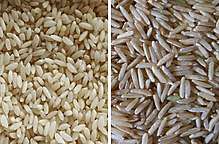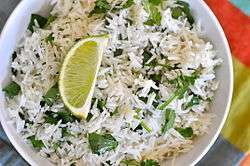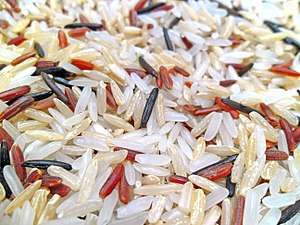Basmati
Basmati (pronounced IPA: [baːsmət̪iː] in the Indian subcontinent) is a variety of long, slender-grained aromatic rice which is traditionally from the Indian subcontinent.[1] As of 2018-19, India exported to 65% of the overseas basmati rice market, while Pakistan accounted for the remainder.[2][3] Many countries use domestically grown basmati rice crops;[4] however, basmati is geographically exclusive to select districts of India and Pakistan.[5]
| Basmati rice | |
|---|---|
 Brown regular rice (left) compared to brown basmati rice | |
| Genus | Oryza |
| Origin | Indian subcontinent |

According to the Indian Government agency APEDA, a rice variety is eligible to be notified as Basmati if it has a minimum average precooked milled rice length of 6.61 mm and average precooked milled rice breadth of up to 2 mm, among other parameters.[6]
History and etymology
"Basmati" derives from the (Sanskrit बासमती, bāsamatī), Hindustani (बासमती, باسمتی) bāsmatī, literally meaning "fragrant".[7] Basmati rice is believed to have been cultivated in the Indian subcontinent for centuries. The earliest extant work to mention basmati rice is Heer Ranjha (1766).[8][9]
Basmati was introduced to the Middle East and Central Asia by Arab and Muslim Indian traders. It remains not only an important part of various cuisines of the Indian subcontinent, but now is also used extensively in Central Asian, Persian, Arab, and other Middle Eastern cuisines as well. This type of rice is grown and exported by those from the Indian subcontinent.[10]
Production and cultivation
India accounts for over 70% of the world's basmati rice production.[11] A small portion of that is being grown organically. Organisations such as Kheti Virasat Mission are trying to increase the amount of basmati rice that is being grown in the Punjab in India.[12][13]
In India
The areas of basmati rice production in India are in the states of Punjab, Haryana, Himachal Pradesh, Delhi, Uttarakhand, Uttar Pradesh and Bihar. India's total basmati production for the July 2011–June 2012 crop year was five million tonnes.[14] From April 2018 to March 2019, India exported 4.4 million metric tons of Basmati rice.[15] In 2015-16, Saudi Arabia, Iran and UAE were the three biggest destinations for India's Basmati rice exports and exports to these three countries accounted for more than half of India's total Basmati exports.[16] In 2015-16, Basmati rice worth USD 3.4 billion was exported from India.[17]
In Pakistan
According to the FAO, Pakistan's original Basmatic area lies in the Kalar bowl between the Ravi and Chenab rivers. 100 percent of the basmati rice cultivation takes place in the Punjab province where total production was 2.47 million tonnes in 2010.[18][19][20]
In Indonesia
Indonesia produced its own local variant of basmati in West Java and Central Kalimantan, with production capacity estimated could reach up to 8.2 tonnes per hectare.[21] Basmati seeds were first brought from Pakistan in 2007, however the seeds were unable to be grown due to soil incompatibility. The Ministry of Agriculture then managed to produce and cultivate a hybrid between basmati and local rice in 2017.[22]
In Nepal
Basmati rice is produced mainly in the Kathmandu Valley and the Terai region of Nepal. Unique Nepali varieties of basmati rice were barred from export to other parts of the world although this bar might be lifted.[23]
Aroma and flavour
Basmati rice has a typical pandan-like (Pandanus amaryllifolius leaf) flavour caused by the aroma compound 2-acetyl-1-pyrroline.[24] Basmati grains contain about 0.09 ppm of this aromatic chemical compound naturally, a level that is about 12 times more than non-basmati rice varieties, giving basmati its distinctive spicy fragrance and flavour.[25] This natural aroma is also found in cheese, fruit and other cereals. It is a flavoring agent approved in the United States and Europe, and is used in bakery products for aroma.[26]
During cooking, the level of 2-acetyl-1-pyrroline decreases. Soaking the rice for 30 minutes before cooking permits 20% shorter cooking times and preserves more of the 2-acetyl-1-pyrroline.[27]
Glycemic index
According to the Canadian Diabetes Association, basmati, brown, wild, short and long grain rice has a "medium" glycemic index (between 56 and 69) opposed to jasmine and "instant" white rice with a glycemic index of 89, thus making it more suitable for diabetics as compared to certain other grains and products made from white flour.[28]
Varieties and hybrids
There are several varieties of basmati rice. Traditional Indian types include basmati 370, basmati 385, and basmati Ranbirsinghpura (R.S.Pura) and Gujjar Chack area in Jammu province situated at the India-Pakistani border in Jammu and Kashmir state of India. 1121 and Muradabadi 6465 Extra Long Grain Rice. Pakistani varieties of basmati rice are PK 385, Super Kernel Basmati Rice and D-98.
Scientists at Indian Agricultural Research Institute, Delhi, used conventional plant breeding to produce a hybrid semi-dwarf plant which had most of the good features of traditional basmati (grain elongation, fragrance, alkali content). This hybrid was called Pusa Basmati-1 (PB1; also called "Todal", because the flower has awns); crop yield is up to twice as high as traditional varieties. Fragrant rices that are derived from basmati stock but are not true basmati varieties include PB2 (also called sugandh-2), PB3, and RS-10.
Approved varieties
Basmati, P3 Punjab, type III Uttar Pradesh, hbc -19 Safidon, 386 Haryana, Kasturi (Baran, Rajasthan), Muradabadi Basmati 6465, Basmati 198, Basmati 217, Basmati 370, Bihar, Kasturi, Mahi Suganda, Pusa 1121.
Indian varieties
Basmati, P3 Punjab, type III Uttar Pradesh, hbc -19 Safidon, 386 Haryana, Kasturi (Baran, Rajasthan), Muradabadi Basmati 6465, Basmati 198, Basmati 217, Basmati 370 Bihar, Kasturi, Mahi Suganda, Pusa 1121.
Related varieties
In Indonesia, the variant of basmati called baroma (basmati aromatik; aromatic basmati) was launched in February 2019.[21] This variant could be grown in low-altitude terrain and managed to attract interest among potential middle-to-upper class consumers.[31]
In the United States, a variety of rice based on basmati called Texmati is grown in Texas.[32]
In Kenya, a rice variety called Pishori or Pisori is grown in the Mwea region.[33]
Basmati certification
The "Basmati Mark" is a DNA-fingerprinting-based certification done by the laboratory of Basmati Export Development Foundation (BEDF).[34]
On February 15, 2016, the Agricultural & Processed Food Products Export Development Authority (APEDA), an autonomous organisation under the Department of Commerce in India, registered Basmati Rice as a product with Geographical Indication (GI).[35]
Adulteration
Difficulty in differentiating genuine basmati from other types of rice and the significant price difference between them has led fraudulent traders to adulterate basmati rice with crossbred basmati varieties and long-grain non-basmati varieties. In Britain, the Food Standards Agency found in 2005 that about half of all basmati rice sold was adulterated with other strains of long-grain rice, prompting rice importers to agree to a code of practice.[36] A 2010 UK test on rice supplied by wholesalers found 4 out of 15 samples had cheaper rice mixed with basmati, and one had no basmati at all.[37]
A PCR-based assay similar to DNA fingerprinting in humans allows adulterated and non-basmati strains to be detected, with a detection limit from 1% adulteration upwards with an error rate of ±1.5%.[38] Exporters of basmati rice use "purity certificates" based on DNA tests for their basmati rice consignments.[39] Based on this protocol, which was developed at the Centre for DNA Fingerprinting and Diagnostics, the Indian company Labindia has released kits to detect basmati adulteration.[40]
Patent battle
In September 1997, an American company, RiceTec, was granted U.S. Patent No. 5,663,484 on "basmati rice lines and grains". The patent secures lines of basmati and basmati-like rice and ways of analyzing that rice. RiceTec, owned by Prince Hans-Adam of Liechtenstein, faced international outrage over allegations of biopiracy. It had also caused a brief diplomatic crisis between India and the United States, with India threatening to take the matter to the WTO as a violation of TRIPS. Both voluntarily and due to review decisions by the United States Patent and Trademark Office, RiceTec lost or withdrew most of the claims of the patent, including, most importantly, the right to call their rice products "basmati".[41] A more limited varietal patent was granted to RiceTec in 2001 on claims dealing with three strains of the rice developed by the company.[42]
See also
- Ambemohar
- Camargue red rice
- Domsiah
- Jasmine rice
- List of rice varieties
- Manoomin
- Oryza sativa
References
- Big money in "specialty rices" Food and Agriculture Organization, United Nations (2002)
- "India Export Statistics". apeda.gov.in. Retrieved 11 July 2019.
- "Pakistani rice: Second to all". dawn.com. April 8, 2019. Retrieved 11 July 2019.
- Rice Sales From Pakistan to Reach Record as Iran Boosts Reserve Bloomberg (February 13, 2014)
- Madhya Pradesh loses GI tag claim for Basmati; India may ask Pakistan to check farming Financial Express (March 19, 2018)
- APEDA. "Eligibility of a Rice Variety to be Notified as Basmati" (PDF). APEDA. Archived (PDF) from the original on December 20, 2019. Retrieved February 2, 2020.
- Oxford English Dictionary, s.v. basmati.
- VP Singh (2000). Aromatic Rices. International Rice Research Institute. pp. 135–36. ISBN 978-81-204-1420-4.
- Daniel F. Robinson (2010). Confronting Biopiracy: Challenges, Cases and International Debates. Earthscan. p. 47. ISBN 978-1-84977-471-0.
- "Rice Sales From India to Reach Record as Iran Boosts Reserve". bloomberg.com. Archived from the original on 2017-05-21. Retrieved 2016-06-09.
- "Basmati rice industry may revive in next harvest 2016-17: Icra". Business Standard. Press Trust of India. April 3, 2016. Retrieved 2018-03-21.
- "De prijs van basmati: witte rijst met een donkere rand - National Geographic Nederland/België". National Geographic Nederland/België. Archived from the original on 2017-06-14. Retrieved 2018-03-21.
- "The Price of Basmati - Journalism Grants". journalismgrants.org. Archived from the original on 2017-04-27. Retrieved 2018-03-21.
- "India's to export record basmati rice in 2012/13". Reuters. July 6, 2012. Retrieved 2013-09-11.
- "India Export Statistics". agriexchange.apeda.gov.in. Retrieved 2020-02-02.
- "Rice Export from India". drdpat.bih.nic.in. Retrieved 2020-02-02.
- "Rice Export from India". drdpat.bih.nic.in. Retrieved 2020-02-02.
- Rice export: ‘Pakistan has potential of $4b but barely touches $1b’. The Express Tribune. February 8, 2012.
- Global market: Pakistani basmati may slip down the pecking order. The Express Tribune. July 19, 2012.
- Cheema, N., 2015. Inefficiencies in Basmati Trade in Pakistan. International Policy Digest, (7 Dec).
- Mediatama, Grahanusa (2019-01-16). "Kemtan akan luncurkan varietas beras basmati bernama bamora". kontan.co.id (in Indonesian). Retrieved 2019-01-31.
- GATRAcom. "Gatracom - Kementan Berhasil Merakit Beras Basmati Asli Indonesia". www.gatra.com (in Indonesian). Retrieved 2019-01-31.
- "Traders call for easing ban on Basmati exports". Kathmandu Post. 12 July 2016.
- S. Wongpornchai; T. Sriseadka; S. Choonvisase (2003). "Identification and quantitation of the rice aroma compound, 2-acetyl-1-pyrroline, in bread flowers (Vallaris glabra Ktze)". J. Agric. Food Chem. 51 (2): 457–462. doi:10.1021/jf025856x. PMID 12517110.
- Big money in "speciality rices" Food and Agriculture Organization, United Nations (2002)
- Fenaroli's Handbook of Flavor Ingredients, Sixth Edition, George A. Burdock (2009), CRC Press, ISBN 978-1420090772, p. 36
- "The Science of Cooking Rice - Article". 2010-07-07.
- "The Glycemic Index". Canadian Diabetes Association. Retrieved 2018-08-30.
- "Basmati Rice Price - 1121 Basmati Rice Price". Latifricemills.com. Retrieved 2018-07-09.
- "Survey on Basmati Rice" (PDF). multimedia.food.gov.uk. March 2004. Archived from the original (PDF) on 2014-05-31. Retrieved 2013-09-11.
- "Indonesia Siap Produksi Massal Beras Premium Baroma". Republika Online. 2019-01-23. Retrieved 2019-01-31.
- Fiaz, N; Khalid, F; Sarwar, MA (2013). "Whiff of Pearls". Rice Plus Magazine,ojs.irp.edu.pk. Archived from the original on 2016-10-02.
- Sanginga, P. C. (2009). Innovation Africa: Enriching Farmers' Livelihoods. London: Earthscan. pp. 301–302. ISBN 978-1-84407-671-0.
- "Basmati Export Development Foundation". apeda.gov.in. Retrieved 2018-03-21.
- "Basmati Export Development Foundation".
- British Retail Consortium (July 2005). Code of practice on Basmati rice Archived 2016-03-04 at the Wayback Machine
- Rice, Tim (2010-01-29). "Probe finds fake basmati". This is Leicestershire. Archived from the original on 2013-05-05. Retrieved 2013-09-11.
- Basmati rice collaborative trial - FA0110. defra.gov.uk
- Archak, Sunil et al. (2007). "High-throughput multiplex microsatellite marker assay for detection and quantification of adulteration in Basmati rice (Oryza sativa)" and Lakshminarayana, V. et al. (2007). "Capillary Electrophoresis Is Essential for Microsatellite Marker Based Detection and Quantification of Adulteration of Basmati Rice ( Oryza sativa)".
- Basmati Testing - Basmati Verifiler Kit Archived 2008-04-04 at the Wayback Machine. Labindia.
- "Bid for patent for basmati rice hits a hurdle", The Hindu, November 5, 2006
- "India-U.S. Fight on Basmati Rice Is Mostly Settled", The New York Times
External links
| Wikimedia Commons has media related to Basmati rice. |
| Look up basmati in Wiktionary, the free dictionary. |
- About patent dispute
- China: India's new basmati export destination
- Rice industry: Lack of branding hurts Pakistan, India moves ahead
- Kannan, Shilpa (February 15, 2008). "India and Pakistan link to protect Basmati". BBC News. Retrieved April 26, 2010.
